|
1938 Audio Equipment Shop Photographs |
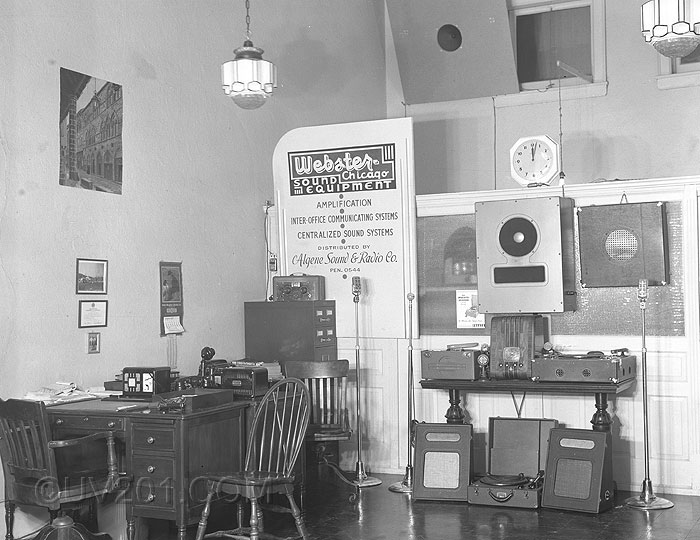 |
| The photographs on
this page show the interior of a audio equipment dealer's shop. The calendar on the wall shows the date to be
sometime in February, 1938, and a Philadelphia Chamber of Commerce
certificate identifies the location. From the name, Al and
Gene must have been the owners. From the pictures, it is clear that their primary business was selling, installing, and maintaining public address systems and equipment. Radio was secondary to their operation, and only two radios are visible in the pictures Their primary product line was that of the Webster Chicago company, later known as Webcor. A brief history of this company, as well as some of their later products, can be seen here. Some of the pictures here may not actually be related to this dealer's activities, but they share a common theme, so I have included them here. They all came from the same source, apparently a photographer's archive. The progression is from most recent at the top, to earliest at the bottom of this page. Note: Many of the images on this page have clickable links to much higher resolution versions. Fortunately, I was able to scan these images directly from 4 by 5 inch negatives, so the quality in most cases is quite good (though the files are quite large). One additional photo from this group may be seen here. |
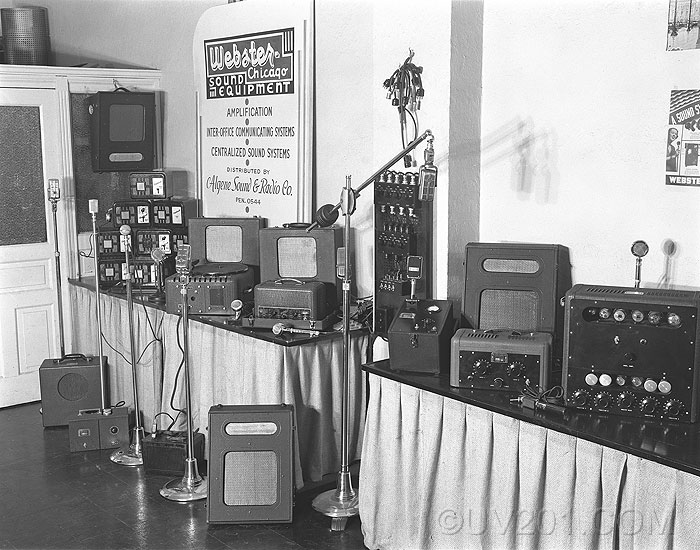 |
| This view of the
shop shows a variety of microphones, amplifiers, and accessories. Of the microphones on floor stands, from left to right, there is an Amperite velocity type (which could be any of 8 similar models with an "RB" prefix), a Brush B1 crystal, a Brush BR2S crystal, and two additional Amperite velocity mikes (the last on a boom type stand). Of the remaining microphones (on desk stands or unmounted), from left to right, is an Astatic D2 crystal, one of unknown make, an Astatic T3 "bullet" crystal (lying on the table), a Bruno model MB velocity (partly hidden behind the boom stand's vertical shaft), what might be a Shure 85A crystal, an Amperite HDH or HDL "Handi-Mike, and another Astatic D2 at the far right. The Shure 85A is part of a Webster sound level meter (the black box directly below it). From left to right, the equipment on the tables include a number of Bakelite-cased Webster Amplicall intercom units, a DC powered portable amplifier and and phonograph combination, possibly a Webster model 530. If you follow the wire from this unit down to the floor, you will see a 6-volt lead-acid storage battery. Normally, this unit would have been used in a mobile installation, and the power would be taken from the vehicle's electrical system. To it's right, is a Webster public address amplifier with a matching speaker behind it. Between the two tables is a patch panel, with a group of interconnecting cables hanging on the wall above it. On the next table is the Webster sound level meter mentioned above, another Webster amplifier, and an elaborate large rack-mounted amplifier of unknown make. This unit has four input channels with individual level controls and a master level control in the center. It appears that each channel has a plug-in matching transformer to adapt it to the particular signal source that is to be used. All of the tubes are accessible from the front for quick replacement. On the floor, to the left of the battery, is still another Webster amplifier and a matching speaker cabinet. |
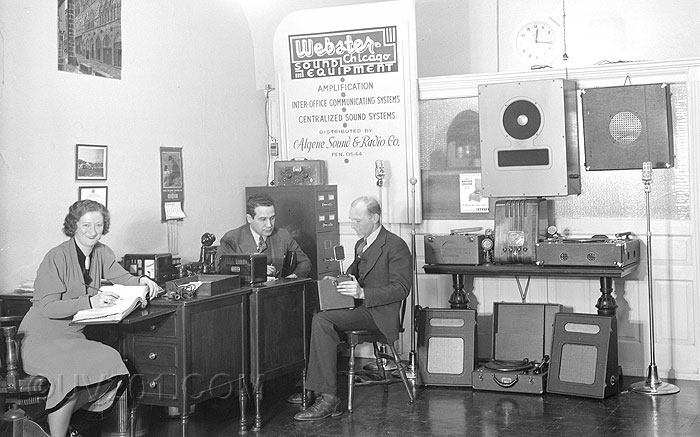 |
| This view shows the opposite side
of the shop. I assume that's Al and Gene sitting there. Some additional
equipment can be seen along the partition which probably hides a
workshop area from public view. You can see the back of a Philco cathedral radio through the pebbled glass window. It would be about 7 years old when this picture was taken, so it is there probably for the use of the employees. Taped to the glass below the Philco is an advertisement for a Presto Junior phonograph recorder, and that is surely the unit on the table in front of it. "A Mirror For Your Voice", is the tag line they used. Directly to the right is the microphone that was supplied with this unit. In the center of the table is the only other radio visible, an Emerson tombstone, model Z159. This model featured a sloping front cabinet that was made by Ingraham. Above the Emerson is a large speaker cabinet, a model KM made by Jensen. To the right of the Emerson is another phonograph unit, which may also be a recorder. The speaker cabinet to the right of the Jensen probably goes with it. On the floor, is a Webster phonograph flanked by two speakers. A Brush and two Amperite microphones can be seen here, but they are probably the same ones seen in the other photograph. The two gentlemen are examining the Webster sound level meter which is seen in the other photo as well. And the owners knew quality, so naturally, a Telechron clock can be seen on the back wall. |
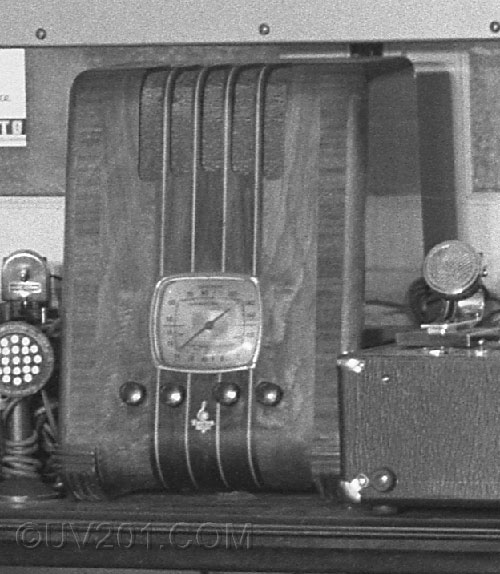 |
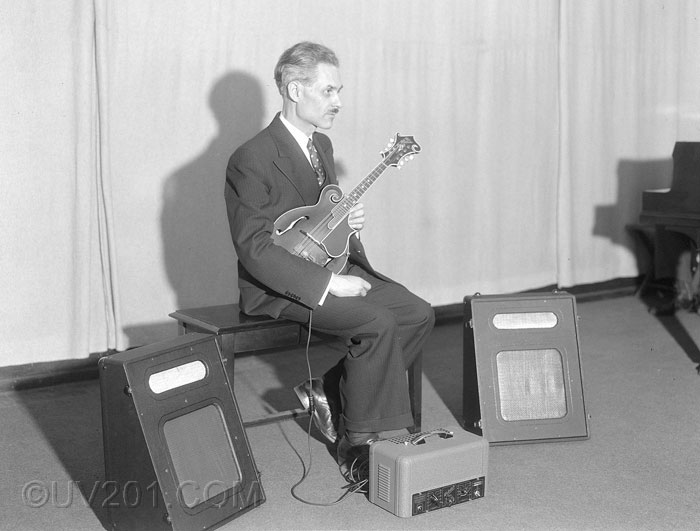 |
| These two pictures may have been
taken at a trade show, as they appear to be a demonstration of the
advantages of electronic amplification for the stringed instrument
player. The same amplifier and speakers as are seen in the
views of the shop are here, and the musician can be seen pointing to
an Amperite model KTH instrument pickup in the second photo.
The two speaker cabinets could be latched together face-to-face for
protection and convenience in transit. The instrument is a lovely and very desirable Gibson mandolin. The musician is Edgar Stanistreet, who played violin with the Philadelphia Symphony. A cropped version of the picture below appeared in the November, 1938 issue of Radio Today magazine. |
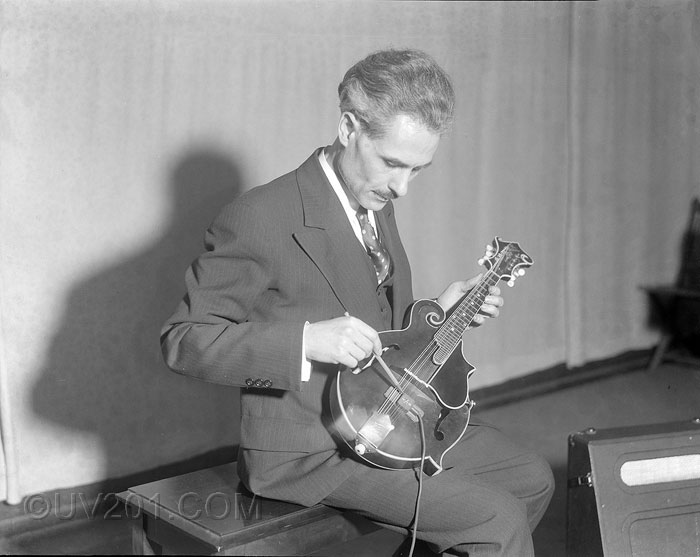 |
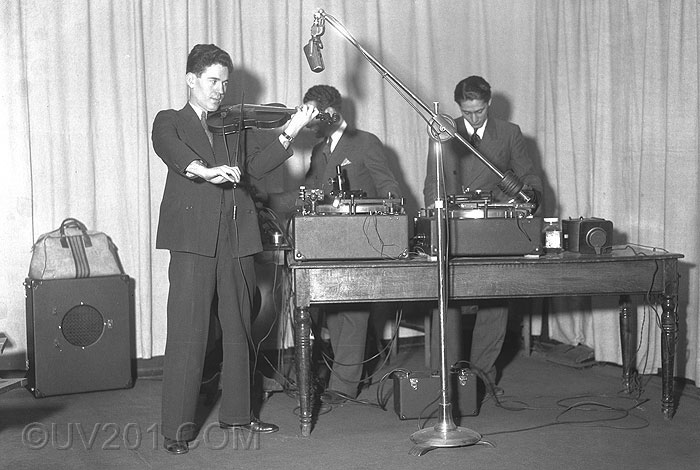 |
| Probably from the
same event, this picture shows an electric pickup on a violin.
The two large units on the table are professional quality disk
recorders not seen in any of the other photos. The microphone,
however, is the same boom mounted Amperite velocity unit as seen in
the shop.
Notice the microscope above the recorder unit on the left. It was normal for recording engineers to carefully examine the record grooves as they are cut to ensure optimum sound quality. At the far right you can see another Telechron clock from the rear. The unit under the table appears to be a microphone preamplifier/mixer. Some additional equipment is hidden behind the performer on a small table. |
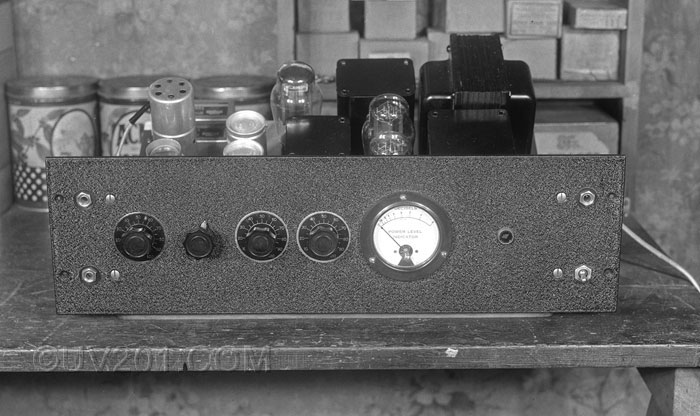 |
| The next three photos show an
amplifier of unknown origin, but it may well have been a custom
built unit, and the pictures may have been taken in the work area at
the back of the shop. The chassis is just a piece of sheet metal, and the sides are wood. From the underside, it is clear that all the tubes are octal-based types. From the appearance above and below, the output tubes are 6B4G's and the rectifier is a 5U4G, and these tubes were introduced in 1936, so that defines the earliest point at which this could have been built. |
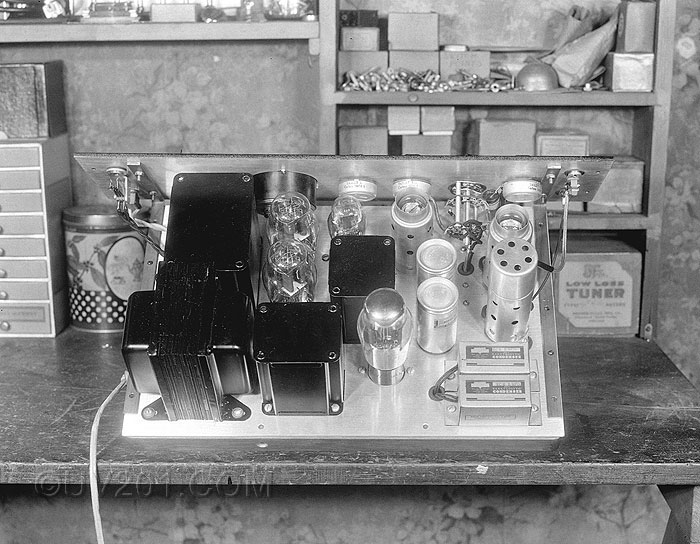 |
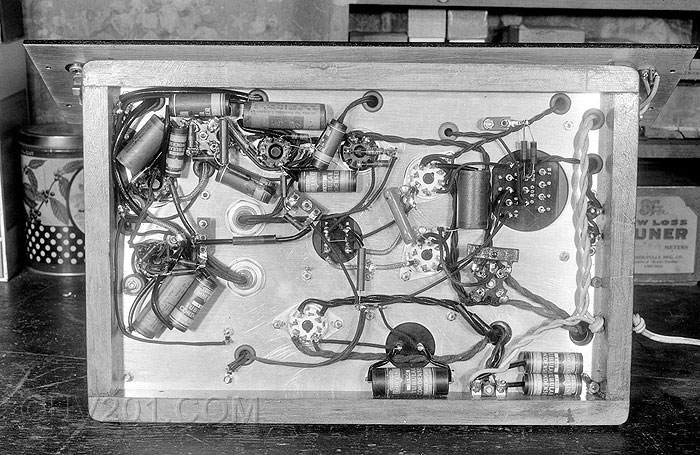 |
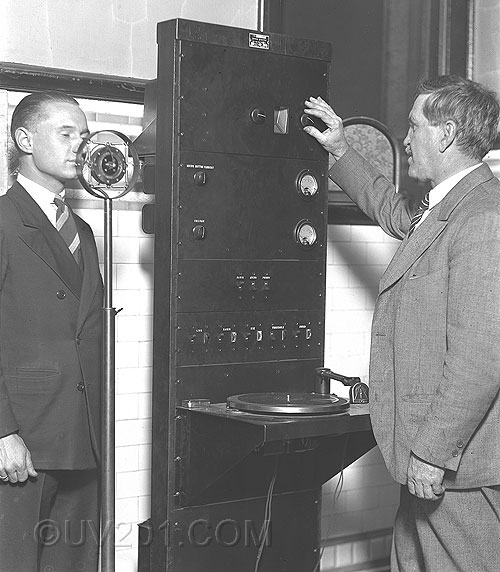 |
| This photograph, and it's mate
below, are earlier. I would guess these were taken circa 1932. In any event, they show a public address installation which consisted of an amplifier rack made by the Samson Electric Company of Watertown, MA. The microphone was made by the Ellis Electrical Laboratory. I can't be certain, but it may be a model 10. The top unit in the rack is a radio receiver. the second unit is an amplifier. The next panel down has switches for the three audio sources (radio, microphone, and phonograph). Below that is a power switching panel, and then a phonograph turntable. A Victor needle tin can be seen at the left. Below the turntable is probably a power supply, and maybe a power amplifier. At the bottom are junction boxes for input power and speaker cabling. |
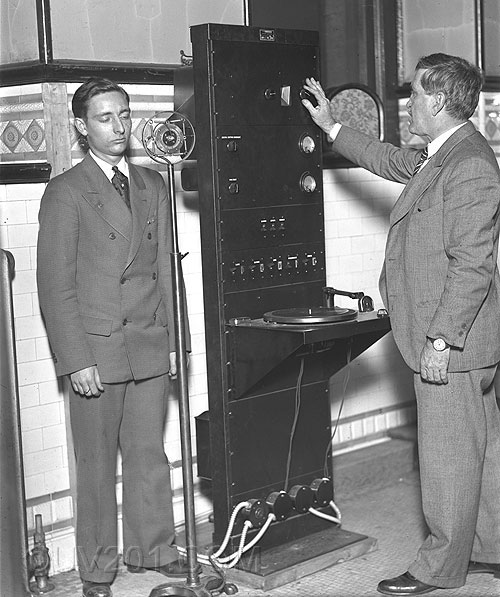 |
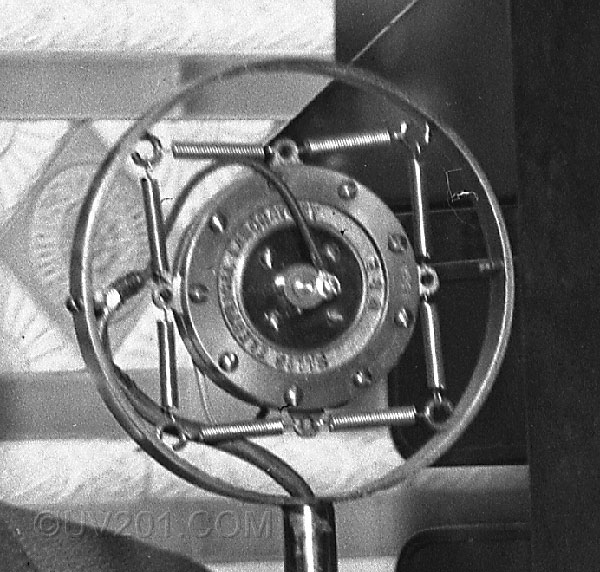 |
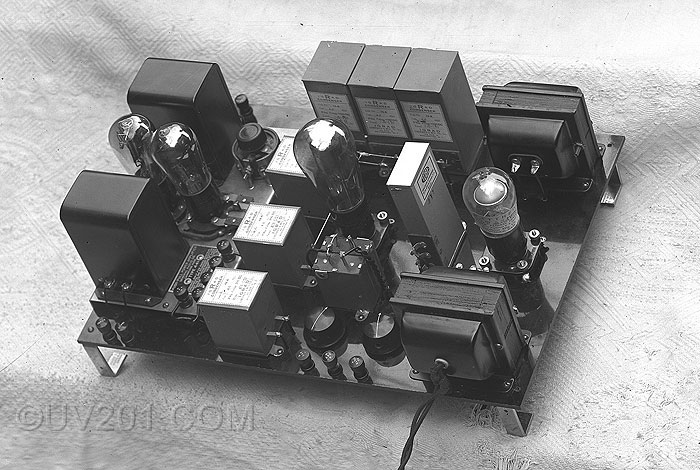 |
| The last two
pictures on this page show two early audio amplifiers. Neither
appears to have been commercially marketed products. More
likely, they were custom units made specifically for clients'
applications. Both would have been driven by another
lower-powered amplifier. The one shown above is the later of the two, probably from 1928 or 1929. It used a commercially manufactured push-pull amplifier unit, the General Radio model 441, which can be seen as a subchassis at the far left. It used two UX-210 triode tubes, and would have been capable of supplying 10-15 watts of audio power. The amplifier chassis was mounted to a large sheet of Bakelite, probably 1/4 inch thick, along with the power supplies needed for operation. The plate supply used a UX-281 half wave rectifier (in the center) and the grid bias supply used a Raytheon BH gas rectifier (at the far right). |
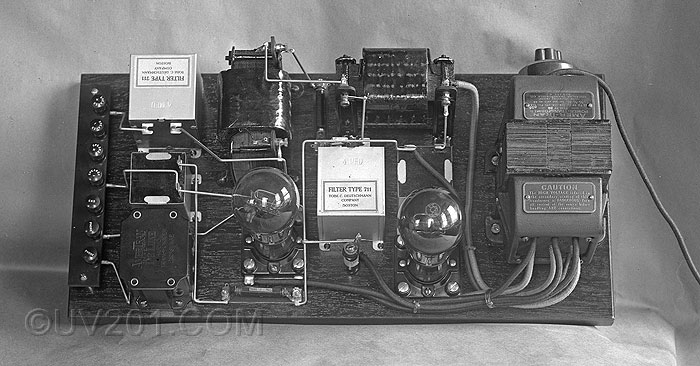 |
| This amplifier, I would say, was
built circa 1927.
The tube on the left is a UX-210 and the one on the right is a UX-216B (the predecessor of the UX-281). This unit would have a power output of about 5 watts. All of the components are mounted on a wood panel. It may be mahogany with a dark finish, or it may have been painted black. It is a well made unit, using the exposed bus-bar style of wiring that was popular in the twenties. Safety was not an issue back then, especially considering that some of the exposed wiring carried about 400 volts DC. |